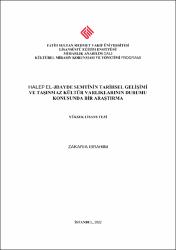| dc.contributor.advisor | Kasmo, Ruba | |
| dc.contributor.author | Ibrahım, Zakarıa | |
| dc.date.accessioned | 2023-04-03T08:06:16Z | |
| dc.date.available | 2023-04-03T08:06:16Z | |
| dc.date.issued | 2022 | en_US |
| dc.identifier.citation | IBRAHIM, ZAKARIA, Halep El-Jdayde Semtinin Tarihsel Gelişimi ve Taşınmaz Kültür Varlıklarının Durumu Konusunda Bir Araştırma, Fatih Sultan Mehmet Vakıf Üniversitesi Lisansüstü Eğitim Enstitüsü Mimarlık Anabilim Dalı Kültürel Mirasın Korunması ve Yönetimi Programı,Yayımlanmamış Yüksek Lisans Tezi, İstanbul 2022. | en_US |
| dc.identifier.uri | https://hdl.handle.net/11352/4454 | |
| dc.description.abstract | Halep, dünyanın en eski sürekli yerleşim yerlerinden biridir. En az dört bin yıldır yerleşim gören bir şehirdir. Bölgesel ve uluslararası ticaret değişim yollarının merkezi olarak coğrafi konumundan birbirini izleyen tarihsel dönemlerde önemini kazanmıştır. Şehrin ekonomik ve sosyal gelişimi, mimarisine yansımıştır. Eski Halep, birçok tarihi eseri, çarşısı ve yerleşim bölgesi ile ünlüdür. 1986 dünya Mirası Listesi'ne yazılı alınmıştır.
El-Jdayde semti, kuzeybatıdaki surların dışında, 15. yüzyılın sonundan itibaren tekstil endüstrileri için bir merkez olarak gelişmeye başlayan eski Halep'teki yerleşim semtlerinden biridir. 17. yüzyılın başlarında bu semt, vakıf, hamam ve ibadethane gibi önemli tarihi eserlerin yanı sıra varlıklı tüccarlar tarafından inşa edilen lüks evler içerir.
Eski Halep Rehabilitasyon Projesi kapsamında, El-Jdayde semti turizm yatırımı için belirlenmiş alanlardan biri olarak kabul edildi ve bu da çok sayıda geleneksel evin otel ve restorana dönüştürülmesi ile sonuçlandı. Semt, kalkınma ve kentsel dönüşüm çalışmalarına tanık oldu.
Ne yazık ki El-Jdayde semti, 2012-2016 yılları arasında şehirde yaşanan silahlı çatışma yıllarında büyük zarar görmüştür. Halep'teki silahlı çatışma hayatın her alanını ciddi şekilde etkiledi ve El-Jdayde semti de dahil olmak üzere tarihi binalara doğrudan zarar verdi. İpşir Paşa Külliyesi -istisnai bir tarihi değer olarak kabul edilen-, çevresindeki tüm binalarla birlikte neredeyse tamamen yıkıldı ve ayrıca El-Hatab Meydanı gibi ana meydanlar ağır hasar gördü. Tez, El-Jdayde semtin tarihi bir kentsel ve mimari çalışmasını, semtin tarihi değerlerinin aydınlatılmasını, tanık olduğu hasar ve kayıpların anlatılmasını amaçlamaktadır.
Çalışmanın sonuçları, semtte gelecekteki müdahaleler hakkında genel tavsiyeler formüle etmek ve bunları savaş sonrası şehir iyileşme süreci entegre etmek için kullanıldı. | en_US |
| dc.description.abstract | Aleppo is one of the oldest continuously inhabited cities in the world. It is a city that has been inhabited for at least four thousand years. It gained importance during the successive historical periods due to its geographical location as the center of regional and international trade routes. The economic and social development of the city has been reflected in its architecture. Old Aleppo is famous for its many historical monuments, markets and residential neighbourhoods. It was inscribed on a World Heritage site in 1986.
The neighbourhood of Al-Jdayde is one of the residential neighbourhood in old Aleppo, which began to develop as a center for the textile industries from the mid 15th century, outside the walls in the northwest. By the early 17th century, the neighbourhood boasted important endowed facilities such as khans, qaysariyyas, coffeehouses, and public baths. In addition to places of worship and luxurious houses built by wealthy merchants.
As part of the Old Aleppo Rehabilitation Project, the Al-Jdayde neighbourhood was designated for tourism investment, resulting in the conversion of many traditional houses into hotels and restaurants. The neighbourhood has witnessed development and urban transformation works.
Unfortunately, Al-Jdayde neighbourhood suffered greatly during the years of armed conflict in the city between 2012 and 2016. The armed conflict in directly damaged historical buildings; including the buildings Ipshir Pasha Complex – considered of an exceptional historical value – were almost completely destroyed along with all the buildings around it, and main squares such as Al-Hatab Square were also badly damaged. The thesis aims to make a historical urban and architectural study of the neighbourhood, to highlight its cultural values and to demonstrate the damage and losses it witnessed.
At the end, general recommendations for future interventions in the neighborhood were formulated in a way that can be integrated in the overall post-war recovery of Aleppo. | en_US |
| dc.language.iso | tur | en_US |
| dc.publisher | Fatih Sultan Mehmet Vakıf Üniversitesi, Lisansüstü Eğitim Enstitüsü | en_US |
| dc.rights | info:eu-repo/semantics/openAccess | en_US |
| dc.subject | Halep, El-Jdayde Semti | en_US |
| dc.subject | Kültürel Mirası | en_US |
| dc.subject | Mirasın Korunması | en_US |
| dc.subject | Tarihi Binalar | en_US |
| dc.subject | Geleneksel Evler | en_US |
| dc.subject | Silahlı Çatışma | en_US |
| dc.title | Halep El-Jdayde Semtinin Tarihsel Gelişimi ve Taşınmaz Kültür Varlıklarının Durumu Konusunda Bir Araştırma | en_US |
| dc.title.alternative | The Neighborhood of Al-Jdayde in the Old City of Aleppo: A Study of Its Historical Development and Its Conservation Condition | en_US |
| dc.type | masterThesis | en_US |
| dc.contributor.department | FSM Vakıf Üniversitesi, Lisansüstü Eğitim Enstitüsü, Mimarlık Ana Bilim Dalı Ana Bilim Dalı | en_US |
| dc.relation.publicationcategory | Tez | en_US |
| dc.contributor.institutionauthor | Ibrahım, Zakarıa | |



















